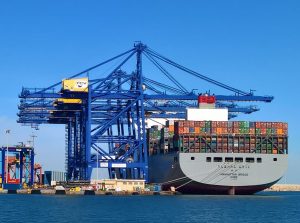
During the first month of the year, Valenciaport handled 443,034 TEU’s, 12.25% more than during the same month of 2017
All goods are kept in positive records.
Ro-ro traffic started the year with an increase of 54.71% and a movement of 1.51 million tons.
València, February 21st 2019.- The Port Authority of Valencia (PAV) closed the first month of the financial year 2019 with a traffic of 443,034 TEU’s, a figure that supposes a higher movement in 48,359 units to January of the previous year and a growth of a 12.25%. These figures make it the best month of January in the history of Valenciaport in container traffic. Considering the data of the statistical bulletin of the PAV, the full containers have experienced an increase of 13.07% thanks, mainly, to the behavior of imports (+ 7.95%) and traffic (+ 20.82%). Exports of full containers, on the other hand, fell by 1.27% while empty containers advanced by 9.97%.
Regarding total traffic, during the month of January, Valenciaport channeled 6,851,112 tons, 19.39% more than in 2018. All the goods (bulks, contaneirised general cargo and conventional general cargo) have initiated the year with a positive evolution and important increases. Foreign trade of general cargo fell by 10.67% to a total of 1,835,134 tons. In particular, imports, with 804,897 tons, that decreased by 5.21%. However, countries such as China (+ 18.14%) and Turkey (+ 29.61%) remain positive. On the other hand, exports also decreased by 14.52%, with 1,030,237 tons despite the good results of traffic to the United States, which increased by 14.30% during the first month of the year. The data of the PAV verify that the global transit has advanced 26,80% in this period.
Data by goods
The conventional general cargo closed the month of January with an advance of 34.88% and a total movement of 1,637,569 tons. This growth is based on good records of cars and their parts, which, with 196,000 tons, increase by 36.74%; and of the machinery, tools and spare parts that, with 161,000 tons, advance 245.26%. Ro-ro traffic, meanwhile, has started the year with an increase of 54.71% and a total movement of 1,505,822 tons. On the other hand, automobile traffic fell by 19.83% to 51,410 units.
The containerized general cargo with 4,819,394 tons, registered an increase of 14.59%. In this section highlights the performance of goods such as construction materials produced, with 371,000 tons and a decrease of 4.32%; other goods, with a movement of 203,000 tons and an increase of 1.92%; and machinery, tools and spare parts, with 121,000 tons and an increase of 24.17%.
Solid bulks have started 2019 with an increase of 28.07% and a total movement of 218,118 tons. This good record is mainly based on the evolution of traffics such as cereals and their flours, which, with 128,000 tons, grow by 9.26%; and natural and artificial fertilizers that, with 31,000 tons, advance a 147.12%. Regarding liquid bulk, Valenciaport has started the year handling 165,382 tons, a figure that represents an increase of 30.29%. By merchandise, the chemical products stand out, with a movement of 41,000 tons and an increase of 11.48%; and diesel, with a traffic of 32,000 tons and a fall of 3.98%.
Passengers traffic
In response to data from the statistical bulletin of the Port Authority of Valencia, in January the port facilities of Valencia and Gandia were used by a total of 55,845 passengers, 11.48% more than during the same month of 2017. In particular, the regular line has been employed by 44,132 people, which means a reduction of 1.38%. Regarding to cruise ship traffic, in January, 11,713 people landed at the port of Valencia, 119.14% more than the previous year.
Traffic par countries and geographical areas
The five countries with the largest volume of goods channeled through Valenciaport during the month of January were: Italy, with 1.05 million tons and an advance of 105.36%; Spain, with 758,000 tons and an increase of 1.37%; China, with 573,000 tons and an increase of 0.20%; United States, with 551,000 tons and an increase of 31.07%; and Turkey, with 446,000 tons and an increase of 82.25%. By geographic areas, the Mediterranean and Black Sea areas stand out, with a total of 2.41 million tons and a growth of 48.43%; and that of the Far East, with a total of 835,000 tons and a decrease of 0.38%.

